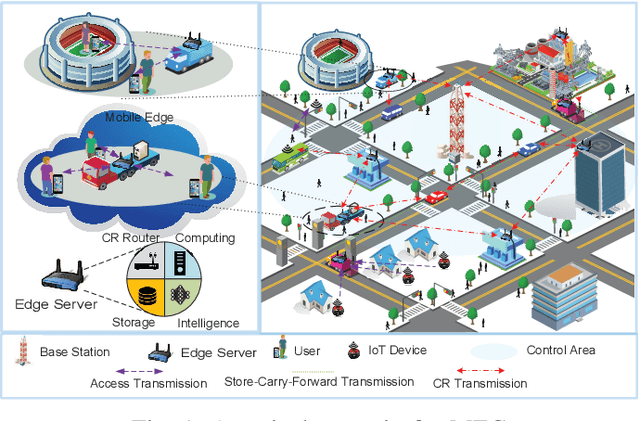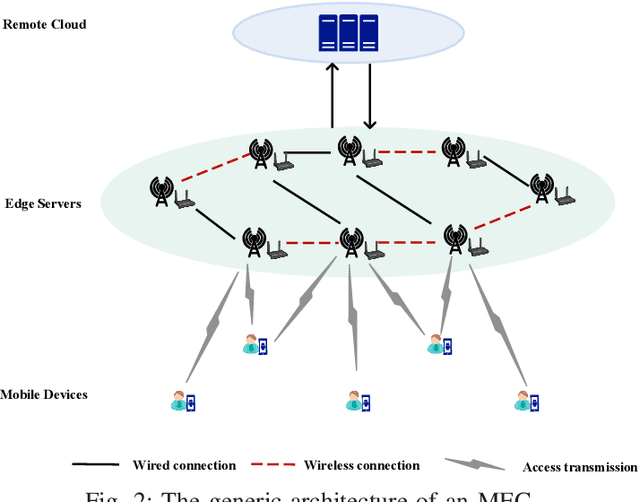Yiqin Deng
Dynamic Uncertainty-aware Multimodal Fusion for Outdoor Health Monitoring
Aug 12, 2025Abstract:Outdoor health monitoring is essential to detect early abnormal health status for safeguarding human health and safety. Conventional outdoor monitoring relies on static multimodal deep learning frameworks, which requires extensive data training from scratch and fails to capture subtle health status changes. Multimodal large language models (MLLMs) emerge as a promising alternative, utilizing only small datasets to fine-tune pre-trained information-rich models for enabling powerful health status monitoring. Unfortunately, MLLM-based outdoor health monitoring also faces significant challenges: I) sensor data contains input noise stemming from sensor data acquisition and fluctuation noise caused by sudden changes in physiological signals due to dynamic outdoor environments, thus degrading the training performance; ii) current transformer based MLLMs struggle to achieve robust multimodal fusion, as they lack a design for fusing the noisy modality; iii) modalities with varying noise levels hinder accurate recovery of missing data from fluctuating distributions. To combat these challenges, we propose an uncertainty-aware multimodal fusion framework, named DUAL-Health, for outdoor health monitoring in dynamic and noisy environments. First, to assess the impact of noise, we accurately quantify modality uncertainty caused by input and fluctuation noise with current and temporal features. Second, to empower efficient muitimodal fusion with low-quality modalities,we customize the fusion weight for each modality based on quantified and calibrated uncertainty. Third, to enhance data recovery from fluctuating noisy modalities, we align modality distributions within a common semantic space. Extensive experiments demonstrate that our DUAL-Health outperforms state-of-the-art baselines in detection accuracy and robustness.
Task-Oriented Communications for Visual Navigation with Edge-Aerial Collaboration in Low Altitude Economy
Apr 29, 2025Abstract:To support the Low Altitude Economy (LAE), precise unmanned aerial vehicles (UAVs) localization in urban areas where global positioning system (GPS) signals are unavailable. Vision-based methods offer a viable alternative but face severe bandwidth, memory and processing constraints on lightweight UAVs. Inspired by mammalian spatial cognition, we propose a task-oriented communication framework, where UAVs equipped with multi-camera systems extract compact multi-view features and offload localization tasks to edge servers. We introduce the Orthogonally-constrained Variational Information Bottleneck encoder (O-VIB), which incorporates automatic relevance determination (ARD) to prune non-informative features while enforcing orthogonality to minimize redundancy. This enables efficient and accurate localization with minimal transmission cost. Extensive evaluation on a dedicated LAE UAV dataset shows that O-VIB achieves high-precision localization under stringent bandwidth budgets. Code and dataset will be made publicly available: github.com/fangzr/TOC-Edge-Aerial.
CP-Guard+: A New Paradigm for Malicious Agent Detection and Defense in Collaborative Perception
Feb 07, 2025Abstract:Collaborative perception (CP) is a promising method for safe connected and autonomous driving, which enables multiple vehicles to share sensing information to enhance perception performance. However, compared with single-vehicle perception, the openness of a CP system makes it more vulnerable to malicious attacks that can inject malicious information to mislead the perception of an ego vehicle, resulting in severe risks for safe driving. To mitigate such vulnerability, we first propose a new paradigm for malicious agent detection that effectively identifies malicious agents at the feature level without requiring verification of final perception results, significantly reducing computational overhead. Building on this paradigm, we introduce CP-GuardBench, the first comprehensive dataset provided to train and evaluate various malicious agent detection methods for CP systems. Furthermore, we develop a robust defense method called CP-Guard+, which enhances the margin between the representations of benign and malicious features through a carefully designed Dual-Centered Contrastive Loss (DCCLoss). Finally, we conduct extensive experiments on both CP-GuardBench and V2X-Sim, and demonstrate the superiority of CP-Guard+.
CP-Guard: Malicious Agent Detection and Defense in Collaborative Bird's Eye View Perception
Dec 16, 2024Abstract:Collaborative Perception (CP) has shown a promising technique for autonomous driving, where multiple connected and autonomous vehicles (CAVs) share their perception information to enhance the overall perception performance and expand the perception range. However, in CP, ego CAV needs to receive messages from its collaborators, which makes it easy to be attacked by malicious agents. For example, a malicious agent can send harmful information to the ego CAV to mislead it. To address this critical issue, we propose a novel method, \textbf{CP-Guard}, a tailored defense mechanism for CP that can be deployed by each agent to accurately detect and eliminate malicious agents in its collaboration network. Our key idea is to enable CP to reach a consensus rather than a conflict against the ego CAV's perception results. Based on this idea, we first develop a probability-agnostic sample consensus (PASAC) method to effectively sample a subset of the collaborators and verify the consensus without prior probabilities of malicious agents. Furthermore, we define a collaborative consistency loss (CCLoss) to capture the discrepancy between the ego CAV and its collaborators, which is used as a verification criterion for consensus. Finally, we conduct extensive experiments in collaborative bird's eye view (BEV) tasks and our results demonstrate the effectiveness of our CP-Guard.
IC3M: In-Car Multimodal Multi-object Monitoring for Abnormal Status of Both Driver and Passengers
Oct 03, 2024Abstract:Recently, in-car monitoring has emerged as a promising technology for detecting early-stage abnormal status of the driver and providing timely alerts to prevent traffic accidents. Although training models with multimodal data enhances the reliability of abnormal status detection, the scarcity of labeled data and the imbalance of class distribution impede the extraction of critical abnormal state features, significantly deteriorating training performance. Furthermore, missing modalities due to environment and hardware limitations further exacerbate the challenge of abnormal status identification. More importantly, monitoring abnormal health conditions of passengers, particularly in elderly care, is of paramount importance but remains underexplored. To address these challenges, we introduce our IC3M, an efficient camera-rotation-based multimodal framework for monitoring both driver and passengers in a car. Our IC3M comprises two key modules: an adaptive threshold pseudo-labeling strategy and a missing modality reconstruction. The former customizes pseudo-labeling thresholds for different classes based on the class distribution, generating class-balanced pseudo labels to guide model training effectively, while the latter leverages crossmodality relationships learned from limited labels to accurately recover missing modalities by distribution transferring from available modalities. Extensive experimental results demonstrate that IC3M outperforms state-of-the-art benchmarks in accuracy, precision, and recall while exhibiting superior robustness under limited labeled data and severe missing modality.
AgentsCoMerge: Large Language Model Empowered Collaborative Decision Making for Ramp Merging
Aug 07, 2024Abstract:Ramp merging is one of the bottlenecks in traffic systems, which commonly cause traffic congestion, accidents, and severe carbon emissions. In order to address this essential issue and enhance the safety and efficiency of connected and autonomous vehicles (CAVs) at multi-lane merging zones, we propose a novel collaborative decision-making framework, named AgentsCoMerge, to leverage large language models (LLMs). Specifically, we first design a scene observation and understanding module to allow an agent to capture the traffic environment. Then we propose a hierarchical planning module to enable the agent to make decisions and plan trajectories based on the observation and the agent's own state. In addition, in order to facilitate collaboration among multiple agents, we introduce a communication module to enable the surrounding agents to exchange necessary information and coordinate their actions. Finally, we develop a reinforcement reflection guided training paradigm to further enhance the decision-making capability of the framework. Extensive experiments are conducted to evaluate the performance of our proposed method, demonstrating its superior efficiency and effectiveness for multi-agent collaborative decision-making under various ramp merging scenarios.
ESFL: Efficient Split Federated Learning over Resource-Constrained Heterogeneous Wireless Devices
Feb 24, 2024



Abstract:Federated learning (FL) allows multiple parties (distributed devices) to train a machine learning model without sharing raw data. How to effectively and efficiently utilize the resources on devices and the central server is a highly interesting yet challenging problem. In this paper, we propose an efficient split federated learning algorithm (ESFL) to take full advantage of the powerful computing capabilities at a central server under a split federated learning framework with heterogeneous end devices (EDs). By splitting the model into different submodels between the server and EDs, our approach jointly optimizes user-side workload and server-side computing resource allocation by considering users' heterogeneity. We formulate the whole optimization problem as a mixed-integer non-linear program, which is an NP-hard problem, and develop an iterative approach to obtain an approximate solution efficiently. Extensive simulations have been conducted to validate the significantly increased efficiency of our ESFL approach compared with standard federated learning, split learning, and splitfed learning.
Collaborative Perception for Connected and Autonomous Driving: Challenges, Possible Solutions and Opportunities
Jan 03, 2024



Abstract:Autonomous driving has attracted significant attention from both academia and industries, which is expected to offer a safer and more efficient driving system. However, current autonomous driving systems are mostly based on a single vehicle, which has significant limitations which still poses threats to driving safety. Collaborative perception with connected and autonomous vehicles (CAVs) shows a promising solution to overcoming these limitations. In this article, we first identify the challenges of collaborative perception, such as data sharing asynchrony, data volume, and pose errors. Then, we discuss the possible solutions to address these challenges with various technologies, where the research opportunities are also elaborated. Furthermore, we propose a scheme to deal with communication efficiency and latency problems, which is a channel-aware collaborative perception framework to dynamically adjust the communication graph and minimize latency, thereby improving perception performance while increasing communication efficiency. Finally, we conduct experiments to demonstrate the effectiveness of our proposed scheme.
Efficient Parallel Split Learning over Resource-constrained Wireless Edge Networks
Apr 07, 2023Abstract:The increasingly deeper neural networks hinder the democratization of privacy-enhancing distributed learning, such as federated learning (FL), to resource-constrained devices. To overcome this challenge, in this paper, we advocate the integration of edge computing paradigm and parallel split learning (PSL), allowing multiple client devices to offload substantial training workloads to an edge server via layer-wise model split. By observing that existing PSL schemes incur excessive training latency and large volume of data transmissions, we propose an innovative PSL framework, namely, efficient parallel split learning (EPSL), to accelerate model training. To be specific, EPSL parallelizes client-side model training and reduces the dimension of local gradients for back propagation (BP) via last-layer gradient aggregation, leading to a significant reduction in server-side training and communication latency. Moreover, by considering the heterogeneous channel conditions and computing capabilities at client devices, we jointly optimize subchannel allocation, power control, and cut layer selection to minimize the per-round latency. Simulation results show that the proposed EPSL framework significantly decreases the training latency needed to achieve a target accuracy compared with the state-of-the-art benchmarks, and the tailored resource management and layer split strategy can considerably reduce latency than the counterpart without optimization.
Actions at the Edge: Jointly Optimizing the Resources in Multi-access Edge Computing
Apr 18, 2022

Abstract:Multi-access edge computing (MEC) is an emerging paradigm that pushes resources for sensing, communications, computing, storage and intelligence (SCCSI) to the premises closer to the end users, i.e., the edge, so that they could leverage the nearby rich resources to improve their quality of experience (QoE). Due to the growing emerging applications targeting at intelligentizing life-sustaining cyber-physical systems, this paradigm has become a hot research topic, particularly when MEC is utilized to provide edge intelligence and real-time processing and control. This article is to elaborate the research issues along this line, including basic concepts and performance metrics, killer applications, architectural design, modeling approaches and solutions, and future research directions. It is hoped that this article provides a quick introduction to this fruitful research area particularly for beginning researchers.
 Add to Chrome
Add to Chrome Add to Firefox
Add to Firefox Add to Edge
Add to Edge